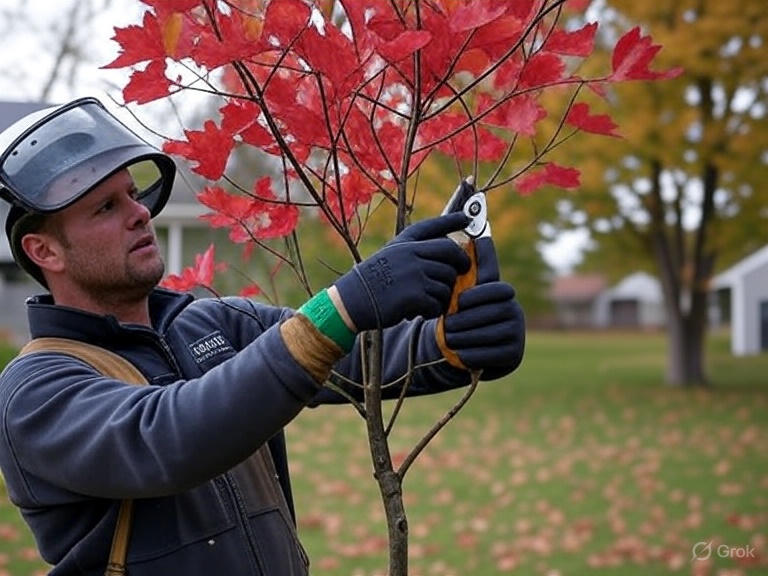Fall Pruning Essentials
Why Integrity Tree Works Recommends Timing It Right for Healthier TreesWhy Fall Is Prime Time for Pruning
Pruning in late fall to early winter (typically November to February in Seattle and the Puget Sound region) is ideal for several reasons. Trees enter dormancy during this period, meaning their growth slows, and they’re less stressed by cuts. The cooler, wetter climate of the Pacific Northwest during these months also reduces the risk of disease and pest issues, as many pathogens are less active in the cold.
Pruning in the Fall Can Make or Break Your Trees
As the leaves turn vibrant shades of red and gold, fall signals a time of transition—not just for your yard’s aesthetics, but for your trees’ health. At Integrity Tree Works, we know that pruning in the fall can make or break your trees’ vitality come spring. Timing your cuts correctly promotes stronger growth, prevents disease, and keeps your landscape safe and beautiful. So, why is fall the sweet spot for pruning, and how can you ensure it’s done right? Let’s dive into the essentials of fall pruning and why Integrity Tree Works is your trusted partner for the job.
Here’s why timing matters:
- Better Healing: Dormant trees focus energy on sealing wounds rather than pushing new growth, reducing the risk of infection.
- Clearer Structure: With leaves gone, it’s easier to see a tree’s branch structure, allowing precise cuts to improve shape and strength.
- Pest and Disease Control: Many pests and pathogens are less active in cooler months, minimizing the chance of spreading issues like oak wilt or fire blight.
- Storm Prep: Removing weak or dead branches before winter storms reduces the risk of damage to your property.
At Integrity Tree Works, we’ve seen firsthand how strategic fall pruning can extend a tree’s lifespan.
What to Prune in Fall in Seattle (and What to Avoid)
Not all trees in the Puget Sound region benefit from fall pruning, and improper cuts can cause harm. Here’s a guide to what’s safe to prune and what’s not:
Trees to Prune in Fall
- Deciduous Trees: Maples, oaks, and birches thrive with fall pruning. Removing dead or damaged branches promotes healthy spring growth.
- Fruit Trees: Apples and pears benefit from light pruning to enhance airflow and boost next season’s fruit yield.
- Ornamental Shrubs: Trim shrubs like hydrangeas (those blooming on new wood) to maintain shape in Seattle’s mild fall climate.
Trees to Avoid
- Evergreens: Douglas firs, cedars, and pines should be pruned in late winter or early spring to minimize sap loss.
- Spring-Flowering Trees: Rhododendrons or magnolias are best pruned after blooming to preserve next year’s flowers.
- Newly Planted Trees: Young trees need time to establish roots in Seattle’s wet soil—avoid major pruning for at least a year.
If you’re unsure about your tree’s needs, a local arborist can assess your landscape and recommend the best pruning plan for the Puget Sound region.
DIY Pruning Tips: Start Small, Stay Safe
While major pruning jobs are best left to professionals, homeowners can handle light maintenance with the right approach. Here are five DIY tips to get started:
- Use Sharp, Clean Tools: Dull or dirty shears can damage branches and spread disease. Sterilize tools with rubbing alcohol between cuts.
- Focus on the 3 Ds: Remove dead, damaged, or diseased branches first. These are easy to spot in fall when healthy branches stand out.
- Cut at the Right Angle: Make clean cuts just outside the branch collar (the swollen area where the branch meets the trunk) to promote healing.
- Don’t Over-Prune: Remove no more than 20-25% of a tree’s canopy in one season to avoid stress. Less is more!
- Stay Safe: Use a sturdy ladder, wear gloves and safety glasses, and avoid pruning near power lines. When in doubt, call us.
When to Call Integrity Tree Works
Some pruning tasks require professional expertise, especially for large trees, hazardous branches, or complex shaping. Here’s when to reach out to us:
- Tall Trees: If branches are out of reach or near power lines, our certified arborists have the equipment and training to handle them safely.
- Structural Issues: Crossing branches or heavy limbs need precise cuts to maintain tree integrity.
- Disease Management: We diagnose and treat issues like fungal infections, ensuring your tree stays healthy.
- Post-Storm Cleanup: Fallen or damaged branches require quick action to prevent further risks.
Our team operates Monday through Saturday, 9am to 5pm, so we’re ready to tackle your pruning needs.
The Integrity Tree Works Difference
At Integrity Tree Works, we’re not just about cutting branches—we’re about preserving your trees’ health and your property’s safety with ethical, expert care. Our certified arborists use industry-best practices, like those recommended by the International Society of Arboriculture (ISA), to ensure every cut supports long-term tree vitality. We also prioritize eco-friendly methods, such as recycling pruned branches into mulch when possible.
We’ve built our reputation on transparency and quality. Our Monday-Saturday availability means you get service when you need it most.
Get Your Trees Ready for Winter
Fall pruning is more than a chore—it’s an investment in your trees’ future. By timing cuts correctly and focusing on health, you’ll enjoy stronger, safer trees when spring arrives. Whether you’re tackling small shrubs yourself or need professional help with towering oaks, Integrity Tree Works is here to ensure your landscape thrives.
Ready to give your trees the care they deserve? Contact Integrity Tree Works for a free consultation. Call us Monday through Saturday, 9am to 5pm, or book online. Let’s make your trees the pride of your yard this fall!


